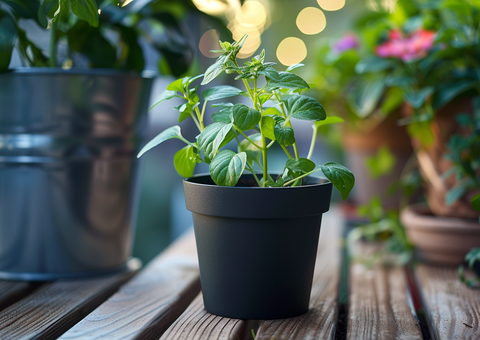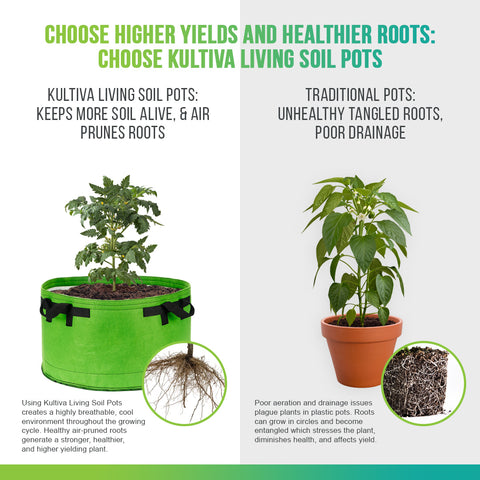
Gardening, an age-old practice that marries the art of nurturing with the science of botany, has long been a beloved pastime for many. At the heart of this endeavor lies the seemingly simple, yet crucial decision of selecting the right type of pot for your plants. This choice is far from trivial, as it can significantly impact plant health, growth, and overall garden aesthetics. Today, gardeners are faced with a plethora of potting options, each with its own set of benefits and considerations. Among these, fabric pots and plastic pots stand out as popular choices, each favored for different reasons by the gardening community.
Fabric pots, made from breathable, often recycled materials, have surged in popularity for their innovative approach to root care and environmental sustainability. Plastic pots, on the other hand, are known for their durability and wide availability, serving as the traditional go-to for both novice and experienced gardeners. The contrast between these two pot types – the classic durability of plastic versus the breathable, eco-friendly nature of fabric – presents a compelling discussion for those looking to optimize their garden's health and productivity.
The purpose of this blog post is to delve into the advantages of fabric pots over their plastic counterparts. By examining factors such as root health, drainage, temperature regulation, and environmental impact, we aim to provide a comprehensive overview of why fabric pots may be the superior choice for gardeners looking to elevate their plant care routine. Join us as we explore the benefits that fabric pots offer, making a case for their consideration as a vital tool in the pursuit of gardening excellence.
Fabric Pots:
Fabric pots, also known as grow bags or cloth pots, are exactly what their name suggests: pots made from fabric. These innovative containers are typically crafted from a breathable, porous material—often a recycled, UV-resistant, non-woven fabric. This design allows for air and water to pass through the pot's walls, promoting healthier root systems through a process known as air pruning. When a plant's roots reach the edge of a fabric pot, the exposure to air stops their outward growth and encourages the development of new, healthy, and fibrous roots within the pot. This key feature prevents the root circling commonly seen in traditional pots and promotes a more vigorous plant growth.
Fabric pots are versatile, lightweight, and suitable for a wide range of plants, from vegetables and herbs to flowers and small trees. They are particularly favored for their portability and are often used in situations where space is limited or where soil conditions are less than ideal. Gardeners looking to maximize their yields in small spaces, or who prefer a more sustainable and root-friendly option, often turn to fabric pots as their solution.
Plastic Pots:
On the other hand, plastic pots have long been the standard in gardening, known for their durability and wide range of sizes and shapes. Made from various types of plastics, including polypropylene (PP) and polyethylene (PE), these pots are designed to be sturdy, lightweight, and resistant to the elements. Their non-porous nature means they retain moisture well, making them a popular choice for plants that require consistent soil moisture. However, this same characteristic can lead to waterlogging and poor air circulation if not properly managed.
Plastic pots are used universally in both residential and commercial gardening. They are the go-to for propagating seeds, nurturing young plants, and housing almost any type of plant, from indoor ornamentals to outdoor perennials. Their traditional use stems from their ease of availability, cost-effectiveness, and the ability to be reused and recycled, although the environmental impact of plastic waste remains a concern.
In summary, both fabric and plastic pots offer unique advantages to gardeners. Fabric pots excel in promoting root health and environmental sustainability, making them ideal for those looking to enhance their garden's growth and reduce their carbon footprint. Plastic pots, with their durability and moisture retention, continue to serve as a reliable option for a wide range of gardening activities. As we explore the benefits of fabric pots in the following sections, it's important to keep in mind the specific needs of your garden and plants, allowing you to make the most informed choice for your green companions.
While learning why fabric pots are gaining traction among gardeners worldwide, we uncover the array of benefits they offer over traditional plastic pots. These advantages span from enhanced root health and superior drainage to environmental considerations, positioning fabric pots as an innovative solution in modern gardening.
Improved Root Health (Air Pruning)

One of the most significant benefits of using fabric pots is the promotion of air pruning, a natural process that fosters healthier root systems. As roots grow to the edge of a fabric pot, they are exposed to air, which naturally prunes them. This pruning process prevents the roots from circling the pot and becoming root-bound, a common issue in plastic pots. Instead, the plant begins to produce new, healthy roots within the pot, leading to a stronger, more vigorous plant. In contrast, plants in plastic pots often suffer from restricted root growth, which can limit nutrient uptake and overall plant health.
Better Drainage and Airflow
The porous nature of fabric pots allows for exceptional drainage and airflow, crucial components for preventing waterlogging and ensuring the roots receive ample oxygen. This enhanced aeration promotes healthier root development and prevents the onset of root diseases associated with poor drainage. Plastic pots, while designed with drainage holes, cannot offer the same level of air circulation due to their non-porous materials. This can lead to water retention at the pot's base, risking root rot and other moisture-related issues.
Temperature Regulation

Another notable advantage of fabric pots is their ability to regulate soil temperature more effectively than plastic pots. The breathable fabric allows heat to escape, keeping the soil cooler during hot weather. This temperature regulation is vital for plant health, as excessive heat can stress plants, leading to poor growth and development. Plastic pots, however, tend to absorb and retain heat, especially when exposed to direct sunlight, potentially overheating the soil and damaging the root system.
Portability
Fabric pots are generally lighter and easier to move than their plastic counterparts, making them an excellent choice for gardeners who like to rearrange their plants or who garden on balconies or other small spaces. Many fabric pots come equipped with handles, adding to their convenience and making them more manageable for transport. This feature is particularly beneficial for those who practice seasonal gardening or who need to move plants to optimize light exposure.
Environmental Considerations
The environmental impact of gardening choices is increasingly coming under scrutiny, and here, fabric pots shine. Many are made from recycled materials and are biodegradable or reusable, reducing waste. This sustainable aspect appeals to eco-conscious gardeners looking to minimize their carbon footprint. Plastic pots, while recyclable, often end up in landfills due to the complexities of plastic recycling and the degradation of plastic quality over time, contributing to environmental pollution.
The shift towards fabric pots in gardening communities worldwide is not without good reason. Their design and material offer clear advantages in promoting plant health, ease of use, and sustainability. As we continue to seek ways to garden more effectively and responsibly, fabric pots represent a step forward in harmonizing our passion for gardening with the wellbeing of the planet.
Cost
The initial cost is another crucial factor to consider. Fabric pots can be more expensive upfront compared to plastic pots. This difference in cost is often due to the materials used in fabric pots and the additional features they offer, such as enhanced drainage, air pruning capabilities, and environmental benefits. However, it's important to factor in the long-term benefits of using fabric pots, such as healthier plant growth, reduced risk of disease, and the potential for higher yields, which can offset the initial investment over time.
Moreover, the sustainability aspect of fabric pots might appeal to gardeners who prioritize environmental impact, making the higher upfront cost a worthwhile investment for those looking to reduce their carbon footprint. While plastic pots may be less expensive initially, the environmental cost of plastic waste and the potential need for more frequent replacement of degraded pots could diminish their appeal from a sustainability perspective.
When considering the practical aspects of durability and cost, gardeners must evaluate their priorities. If longevity and initial cost are paramount, plastic pots might be the preferred choice. However, for those who value plant health, environmental sustainability, and are willing to invest in the long-term benefits of their gardening practices, fabric pots offer an attractive alternative despite their potential limitations. Balancing these factors against the specific needs and goals of your garden will guide you towards the best potting solution for your green sanctuary.
In navigating the world of gardening, the selection of an appropriate pot type emerges as a decision of surprising consequence, one that extends its influence well beyond mere aesthetics. This exploration into the comparative benefits of fabric and plastic pots reveals a landscape where choices tangibly affect plant health, garden sustainability, and even our broader environmental footprint.
Fabric pots stand out for their ability to promote healthier root systems through air pruning, a natural process absent in the confines of plastic pots. This key feature alone can lead to more vigorous plant growth and increased yields, setting fabric pots apart as a choice conducive to the well-being of your garden. Moreover, the superior drainage and airflow provided by the porous nature of fabric mitigate risks of waterlogging and diseases, further underscoring the health benefits of this option. The ability of fabric pots to regulate soil temperature adds another layer of protection for your plants, particularly during the peak of summer's heat.
Beyond the immediate benefits to plant health, the portability of fabric pots offers practical advantages for gardeners, making it easier to manage space and adapt to changing conditions. And perhaps most compelling in today's environmentally conscious climate is the sustainability factor; fabric pots, often made from recycled materials, present an eco-friendlier alternative to the traditional plastic pot, aligning gardening practices with the principles of environmental stewardship.
Yet, practical considerations such as durability and cost remind us of the complex calculus involved in this choice. While fabric pots may offer numerous advantages, their typically higher upfront cost and shorter lifespan compared to plastic pots suggest a trade-off that each gardener must evaluate.
In conclusion, the decision between fabric and plastic pots is not merely a matter of preference but a reflection of priorities—be they plant health, garden sustainability, practicality, or environmental impact. As we strive to create gardens that not only thrive but also harmonize with our ecological values, the choice of potting solutions emerges as a pivotal consideration. Gardeners are encouraged to weigh these factors in light of their specific needs, aspirations, and conditions, selecting the option that best cultivates the flourishing of both their gardens and the planet.
